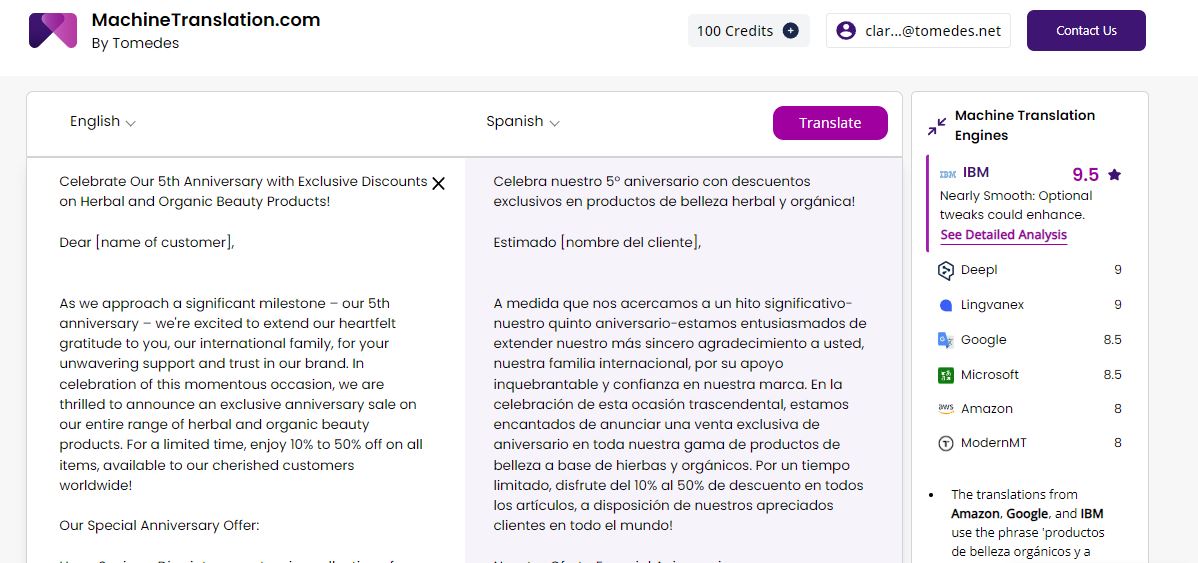February 5, 2024
How to Translate Emails to Spanish with Machine Translation
Since we have already discussed how to translate emails and its importance in making a more multilingual-friendly business for international customers, let's delve deeper into the topic by going through different markets.
Today, we will explore the Spanish market, since it has one the largest number of language speakers in the world. We will also discuss how you can use machine translation to translate emails from English to Spanish and vice versa.
When to Leverage Machine Translation for Spanish Emails
Machine translation is not a one-size-fits-all solution. Its application in how you translate emails from Spanish to English and vice-versa depends on the context of your content.
Below are some scenarios wherein machine translation can be used to translate emails to Spanish from English and other languages as follows:
-
Quick Internal Communications: For informal, non-sensitive communications within an organization, machine translation can speed up the exchange of information without the need for perfect accuracy.
-
Preliminary Drafts: Creating initial drafts of customer-facing multilingual emails in Spanish can be efficiently handled by machine translation, saving time and resources. However, to make sure the content is 100% accurate, it will still require a human translator to review it.
-
High-Volume Correspondence: Businesses that deal with a significant amount of customer inquiries may find machine translation invaluable in managing these interactions. Though it might not always be perfectly accurate, it allows for timely responses.
-
Understanding Foreign Emails: For recipients who are not fluent in Spanish, machine translation provides a quick way to understand the gist of incoming emails, aiding in faster decision-making and response drafting.
5 Essential Steps for Precise Spanish Email Translation
Achieving accuracy in machine-translated emails involves more than just inputting text and accepting the first result. We listed below the steps you can take to enhance the quality of your content if you were to translate emails from English to Spanish.
Step 1: Analyzing the English Email Context
Before embarking on the translation process, it's crucial to dive deep into the context of the English email. Start by discerning the email's primary purpose and who its intended recipients are.
This step is foundational in determining whether the communication leans towards a formal or informal tone, which directly influences how the translation should be approached.
For this example, we made this English email newsletter that announced an e-commerce business’ upcoming anniversary and how they’ll be offering discounts on all their products.
Since we wanted to make things efficient, we used generative AI to create an email. After reading the content, we made slight edits to it to make it more in line with our objectives for this sample newsletter.

After making sure that the English email was grammatically correct and had the right message, we had it translated through our AI translation aggregator.

Through this, we were able to identify which machine translation engine supports Spanish on the platform and generate the most accurate translations. On the right side of the tool, you can see the different engines and an analysis generated.
By clicking on the See Detailed Analysis, you can get an analysis of each segment of the machine-translated text. It's just one of the many features found in our translation aggregator that allows it to be a great tool used to translate emails to Spanish, as your language professional can now easily identify which parts need editing the most.
Step 2: Grasping the Core Message and Intent
After analyzing the context of the English email, the next critical step is to fully understand and capture the core message and the intent behind it. This understanding is crucial for ensuring that the translation not only conveys the same information but also elicits the intended response from the reader.
You will need to break down the email into its main ideas or points. This will help you ensure that no critical information is lost or misrepresented in the translation.
Through this, you can anticipate the action or reaction of your recipients. This can make the translation process run more smoothly and give an idea to your post-editor on how to best approach the translation process.
Pay attention to the subtleties in the language that might indicate urgency, importance, or a casual tone. These nuances are essential for maintaining the email's original tone and intent and will be a factor in whether you will need light or full post-editing.
Step 3: Language Adaptation for Clarity and Accuracy
Translating emails into Spanish requires more than just converting words from one language to another. It involves adapting the message to ensure that it is both clear and accurate, making it understandable to the recipient without altering the original meaning.
-
Simplification: Use simple, clear language to avoid confusion. Complex sentences and jargon can be misunderstood, so it's often better to err on the side of simplicity.
-
Cultural and Linguistic Nuances: Adapt idioms, metaphors, and cultural references so they make sense to a Spanish-speaking audience. This might mean finding a Spanish equivalent or rephrasing the idea to convey the intended meaning without relying on direct translation.
-
Technical Terms: For any specialized language or acronyms, find the appropriate Spanish equivalent or provide a brief explanation. This ensures that the message remains accessible to all recipients, regardless of their familiarity with the subject matter.
Step 4: Matching Formality and Tone to the Spanish Audience
The level of formality and the tone used in an email can significantly affect how the message is received. Spanish, in particular, has formal and informal registers that are more distinctly used than in English, making it crucial to choose the right level of formality.
Consider the relationship between the sender and the recipient. You might have to adjust how you translate emails from English to Spanish by considering using formal or informal tones and identifying which one would be more efficient for your clients. By adjusting the tone to match these expectations can greatly enhance the email's effectiveness.
Step 5: Ensuring Grammatical Accuracy and Proofreading
The final step involves meticulously checking the translated email for grammatical accuracy and polishing the language. This step is vital for ensuring professionalism and clarity in communication.
-
Grammar and Spelling Checks: Utilize Spanish grammar-checking and other CAT tools to identify and correct errors. Pay special attention to verb conjugations, gender agreement, and proper punctuation, which are common sources of mistakes.
-
Proofreading: If possible, have a native Spanish speaker proofread the translation. They can catch errors that automated tools might miss and provide feedback on the email's tone and formality.
-
Final Review: Before sending the email, give it a final review to ensure that the translation accurately reflects the original message's intent, tone, and content. This review is your last chance to make adjustments and ensure that the email conveys professionalism and respect to the recipient.
Translate Spanish Emails with Confidence Using MachineTranslation.com
It cannot be denied that machine translation emerges as a pivotal tool, facilitating quick internal communications, creating preliminary drafts, managing high-volume correspondence, and understanding foreign emails, albeit with an emphasis on the context of content for optimal application.
Through a comprehensive approach involving analyzing the English email context, gravitating to the core message and intent, adapting language for clarity, matching formality to the audience, and ensuring grammatical accuracy, businesses can harness machine translation to bridge linguistic gaps efficiently. By employing platforms like MachineTranslation.com, which offers detailed analyses and comparisons across different translation engines, your business can achieve more accurate and effective email translations for your Spanish-speaking users.